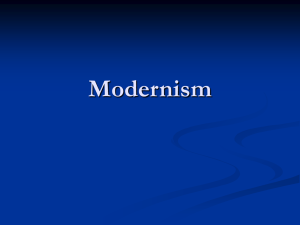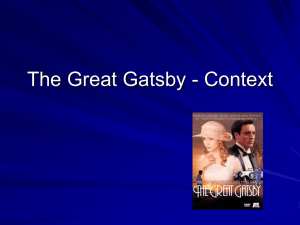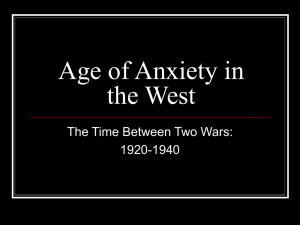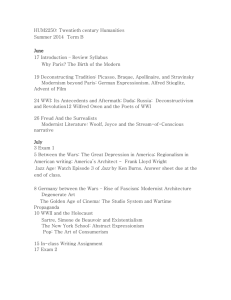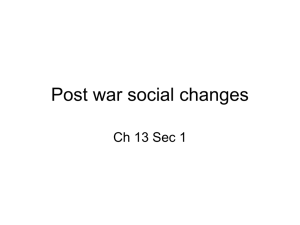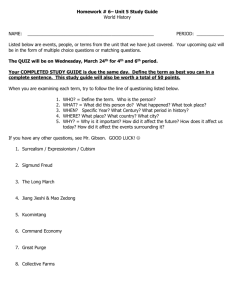Chapter Twenty-One Between the World Wars
advertisement
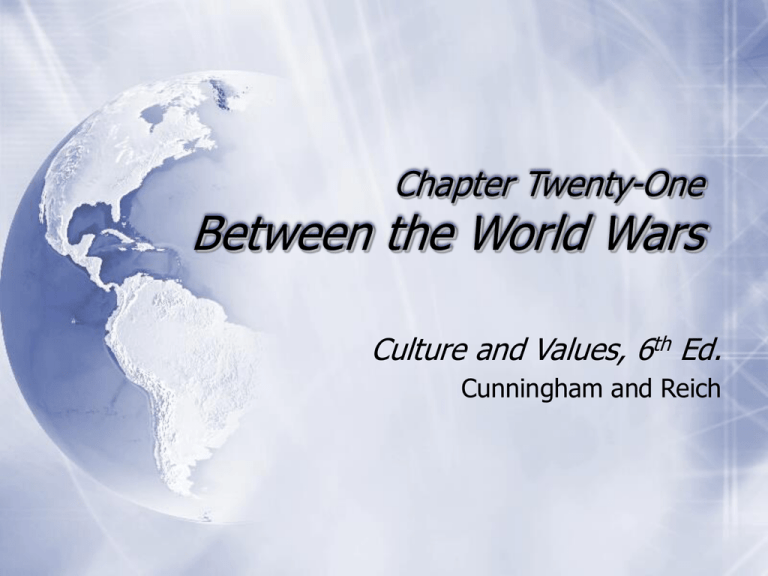
Chapter Twenty-One Between the World Wars Culture and Values, 6th Ed. Cunningham and Reich The Great War and Its Significance Drastic loss of life Sociopolitical consequences October Revolution Hitler’s National Socialist movement Cultural consequences Transportation, communication Entertainment Literary Modernism Modernist temper T.S. Eliot (1888-1965) Necessity of cultural continuity The Wasteland Four Quartets James Joyce (1882-1941) Cultural stability found through art Epiphany, autobiography Alienated artist Literary Modernism Franz Kafka (1883-1924) “Kafkaesque” Guilt, loss, oppression, violence Virginia Woolf (1882-1941) Writer, critic (Bloomsbury Group) Social, economic, and intellectual discrimination against women Revolution in Art: Cubism Analytical Cubism Geometric qualities, flat planes, 2-d linearity Picasso’s Les Demoiselles d’Avignon (1907) Braque’s Violin and Palette (1909-1910) Synthetic Cubism Post-war color, vitality, expressiveness Picasso’s Three Musicians (1921) Revolution in Art: Cubism Piet Mondrian (1872-1944) Marc Chagall (1889-1985) Rufino Tamayo (1899-1991) Women of Tehuantepec (1939) Wassily Kandinsky (1866-1944) Expressionist, non-objective art Freud, the Unconscious, and Surrealism Interpretation of Dreams (1900) Id, ego, superego Dreams and the unconscious mind Psychoanalysis as philosophy Human and cultural behaviors Surrealism Breton’s Manifesto of Surrealism (1924) Freud, the Unconscious, and Surrealism Dalí’s The Persistence of Memory (1931) Kahlo’s Self-Portrait (1937) René Magritte (1898-1967) Influence of film Dalí and Buñuel, Jean Cocteau Paul Klee (1879-1940) Cubist, Expressionist, Surrealist The Age of Jazz African-American experience, heritage Intonations, rhythms Spirituals “Blue note” / the Blues Ragtime From New Orleans to Chicago Black Jazz in Anglo culture Symphonies, operas, swing The Age of Jazz George Gershwin (1898-1937) Jazz in symphonic, operatic works Rhapsody in Blue (1924) Porgy and Bess (1935) Duke Ellington (1899-1974) Orchestra virtuoso, prolific composer Extended jazz idiom to larger arena The Harlem Renaissance African American writers, artists, intellectuals, musicians Themes of African American experience Roots, racism, culture, religion W.E.B. Dubois (1868-1963) African American self-identity, cultural identity, racial identity Ballet: Collaboration in Art Artistic integration: setting, movement, music, narrative Serge Diaghilev’s Ballet Russe (1909) Vast musical commissions Parade (1917): Diaghilev, Cocteau, Satie, Picasso Art as Escape: Dada Protest against war Nonsense language, dissonant music, anarchic irreverence Tristan Tzara’s Dada manifesto (1918) Marcel Duchamp (1887-1968) Mobiles, ready-mades L.H.O.O.Q. (1919) Art as Protest: Guernica Picasso’s protest against inhumanity Hope in the face of horror Inspired by destruction of war Social, pivotal document Expressionistic, Cubist Technical experimentation Art as Propaganda: Film Propaganda as high art Radio, film Educate, persuade, shape public opinion Sergei Eisenstein (1898-1948) Strike! (1924), Ivan the Terrible (1944, 1946) Class struggle, the working class, socialism Alexander Nevsky with Prokofiev (1938) Potemkin and the October Revolution (1925) Art as Propaganda: Film Leni Riefenstahl (1902-2003) Triumph of the Will (1936) Documentary of 1934 Nazi congress Glorification of Nazi virtues Olympia (1938) Documentary of the 1936 Berlin Olympics Homage to Hitler vs. beauty of sport Photography Increased mobility, immediacy of image Man Ray (1890-1976) László Moholy-Nagy (1895-1946) The “f/64 Group” Direct, nonmanipulative pictures Images from the Great Depression Commissioned by FSA and USDA Art as Prophecy: From Futurism to Brave New World Futurists Valued industrialization, urbanization Filippo Tommaso Marinetti (1876-1944) Lewis’s Babbitt (1922) “a chicken in every pot…” Mindless materialism Huxley’s Brave New World (1932) Technology as tool for totalitarian control Chapter Twenty-One: Discussion Questions What aspects of the “modernist temper” can be found in the works of the Harlem Renaissance writers and African American Jazz musicians? What are the personal and cultural expressions found behind these artistic forms? Explain, citing specific examples. In light of the “modernist temper,” why were Freud’s theories so popular? In what sense does psychoanalytical theory abandon the explanation of human motivation that has been long held by Western Europeans? What does this shift in understanding signal about the twentieth century? Explain. Consider the ways in which film was used in the early twentieth century as propaganda. In what ways does the cinematic medium continue to serve in this way? What types of cultural, social, and political values are asserted through popular film and other visual media of the twenty-first century? Explain. To what extent do you agree or disagree with Huxley’s assertion that technology makes individuals dependent on totalitarian forces? Do you feel that our dependency on technology puts us at risk as a culture? …as a free people? Explain.
